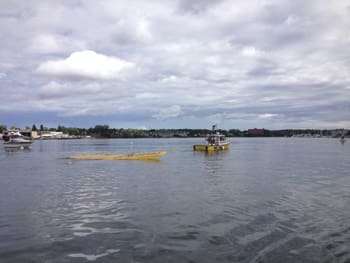I was on my usual run out to Portland Head Light in Cape Elizabeth, Maine, when I heard a cryptic transmission over the VHF: Sea Tow was requesting that the U.S. Coast Guard issue a security call on its behalf for the towing of a “submerged object” into the ship channel and straight into Portland Harbor.
On June 24, a small airplane, a Stinson 108, had crashed off Portland Head Light. It was a sad story. The pilot had called his wife from the air that morning as he buzzed their house, and then flew out to the Head Light where he was planning on dipping his wings for his daughter and grandchildren. Inexplicably, the plane crashed, sinking in 35 feet of water, just 100 yards off the lighthouse. The pilot escaped from the plane, only to die during the rescue attempt. The National Transportation Safety Board is currently conducting an investigation.
In the ship channel that morning, I saw the little yellow Sea Tow boats clustered around the rocks, and over the course of the afternoon watched them chug at a rate of one knot or less with the yellow plane in tow. The VHF calls persisted all morning, mostly frantic pleas for no boat- and ship-wake in the vicinity.
Curious, I called the owner of the Sea Tow franchise for more. Sandy Ogden explained that he was hired by the insurance carrier. First, he and his crew were asked to conduct a survey dive for the Federal Aviation Administration. Sea Tow contracted diver Joe Buxton, who photographed and took video.
The following day, the morning I observed them, the Sea Tow crew returned to the wreck site, and the diver secured a towing bridle on the plane by passing it through the struts and the open cockpit doors. The bridle was secured to the towing bitt of one of three Sea Tow vessels, and then another towline was run to a second vessel, some 100 yards ahead. The diver then placed an airbag onto the propeller, and inflated it with a portable air tank, so that the plane began to rise, nose-first. As soon as this happened, the plane began to move — at a rate of one knot, according to Ogden, on the flood tidal current.
The vessels on the surface started their tow, maintaining bare steerageway. Swimming along with the plane, the diver then secured airbags around the aircraft so that it could be brought to the surface. Unfortunately, the plane’s tail snagged some fishing gear and the plane nose-dived back to the bottom, straining the towline and causing momentary panic on the surface. One of the captains shouted on the VHF that “she was pulling real hard,” a desperate edge to his voice.
The diver eventually freed the plane and it floated gently to the surface. From there, they were able to tow the plane at two knots over the ground — a knot of flood current and a knot of boat/plane speed. Luckily for them, there was no serious commercial traffic that day. Ogden said they towed the plane to South Port Marine in South Portland, where it was hauled out for a more complete survey. It was a somber but curiously exciting funeral procession.

